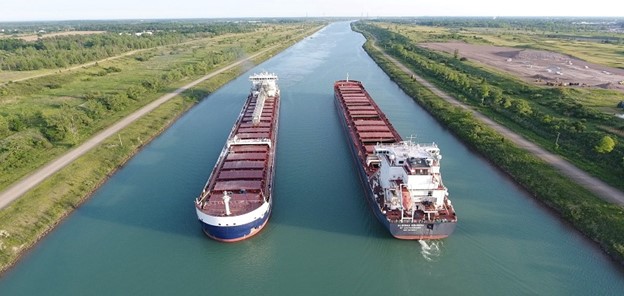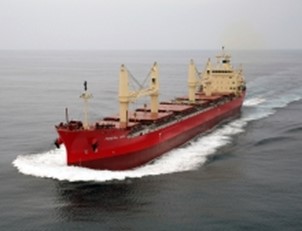Ships on the Great Lakes St. Lawrence Seaway can be broken down into two categories.
- Domestic vessels, also referred to as “lakers.”
- International vessels/ocean-going, also referred to as “salties.”
Domestic Fleet:
Lake vessels are specifically constructed to transport dry cargo in the Great Lakes and St. Lawrence River. Their design is unique to the weather, wave action, and ice conditions on the great lakes and are not structurally authorized to operate on the open ocean. Most lakers are equipped with self-unloading equipment which allows the vessel to unload cargo without the need for shore side labor or equipment. These vessels are often referred to as “self-unloaders”. Lakers without the self-unloading equipment are sometimes called “straight deckers” or “bulkers”. [1]
Tankers also transit the system. Tankers primarily operate within the Great Lakes Seaway basin but have the capability to operate overseas. There are a number of tug/barge operators within the system as well.

Photo: Algoma Central Corporation Vessels - Lakers
International Fleet:
The majority of salties that call the Great Lakes handle dry bulk and/or breakbulk cargoes. Often these vessels may carry steel cargoes into the Great Lakes and export grain cargoes out. Salties are designed to handle both lake and ocean conditions and can operate almost anywhere in the world.
Ocean vessels require a pilot to board the vessel upon entering the Great Lakes. As the Great Lakes/Seaway is a bi-national waterway system, there are both Canadian and U.S. pilotage organizations that alternate onboarding the vessels. The pilot’s responsibility is to ensure that the ocean vessel navigates through the Great Lakes/Seaway safely as these waters are not familiar to the ocean-going captains who call various ports around the world on a regular basis.
Salties usually have an agent located on land that represents their vessel. The agent’s responsibilities include but are not limited to: ordering tugs, ordering pilots, supporting the rectifying of mechanical issues, liaising with longshoremen, assisting with vessel crew changes, and coordinating the ship’s mail.

